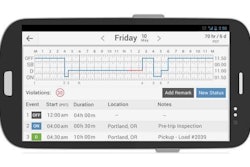
Like Minnesota-based owner-operator Randy Carlson, whom I wrote about yesterday, e-log-exempt South Carolina-based small fleet owner-operator Lee Epling got in touch yesterday looking for clarification about, ultimately, what amounted to the difference what in regulatory terms is known as an Automatic Onboard Recording Device (an AOBRD) and what FMCSA’s lately been calling simply “electronic logging software.”
Epling wondered, principally, whether he’d be able to keep utilizing the KeepTruckin logbook software come this December 17, when grandfathered AOBRDs will no longer be permissible for logging, requiring upgrade to ELDs.
Or, he suggested, in his case, would he be forced to return to paper entirely? “Can an exempt truck still use the AOBRD version for recording HOS?… It’s nice, easy and keeps a six-month record automatically,” he asked. “I am not the only person with this question. I sure don’t want to go back to ‘paper’ logs. It’s expensive, and a pain in the butt.”
Epling likewise added that he uses the KeepTruckin logbook without the link to his engine control module. Reality is he’s not using an AOBRD, but rather “electronic logging software,” as FMCSA has been calling it lately, which will remain permissible for those with exempt equipment or otherwise exempt from the mandate.

The key differentiator between the two:
**An AOBRD, in many ways, is akin to an ELD — tethered in some way to the truck’s movement itself, so that, in motion, the record is not alterable. Most anymore accomplish that through an ECM link just like an ELD, and in some cases have much of the same functionality, such as automatic switching of status to drive with movement, speed, time in motion, etc. What everybody once called “e-logs,” more or less, before the ELD rule.
**Logging software, however, is the functional equivalent of a paper log on some kind of screen, many with automatic electronic back-ups like Epling describes for what he uses and other useful functionality for electronic signature and the like, permissible with FMCSA guidance updated in 2014.
Like Carlson, since Epling’s in an exempt truck, nothing changes for his method of keeping his logs at the near-yearend deadline. I hope that helps clear up the AOBRD/logging-software difference, generally.
And he’s right about the confusion, in more ways than one — a small fleet owner I talked to recently had his drivers over the past year and a half utilizing a user-friendly logbook app they all liked. In this case, though, the owner wasn’t exempt from the mandate, with newer trucks in operation. He’d installed an ECM link from a different company to take advantage of analytical possibilities it engendered, recording truck data for the purpose of delivering driver bonuses based on performance and taking advantage of analytical possibilities to improve efficiency where possible.
Problem was those logbook apps were just that, logbook apps and not AOBRDs. The ECM plug-in could well have been an AOBRD, but only if drivers were using linked software from that manufacturer to record their logs. The combination of the two in this case did not an AOBRD make (sorry to sound a little Yoda, there…). Any case, technically, the owner realized about midway through the ELD mandate’s first two years that he was in violation of the ELD rule. Fortunately, it wasn’t a scale house officer who led him to the discovery.
Speaking of scales, if you are using logging software in an exempt operation, as I wrote some years back, given guidance gray areas around the issue, retaining the ability to print those logs could still be useful/de facto required in some jurisdictions. Epling carries a wi-fi printer in the truck, “just for that reason,” he says. Most often, however, he finds that officers are happy to accept an email of his logs.
“The state can print if it so chooses,” Epling says. “I pay for their ink and paper. I’m not going to waste mine.”









